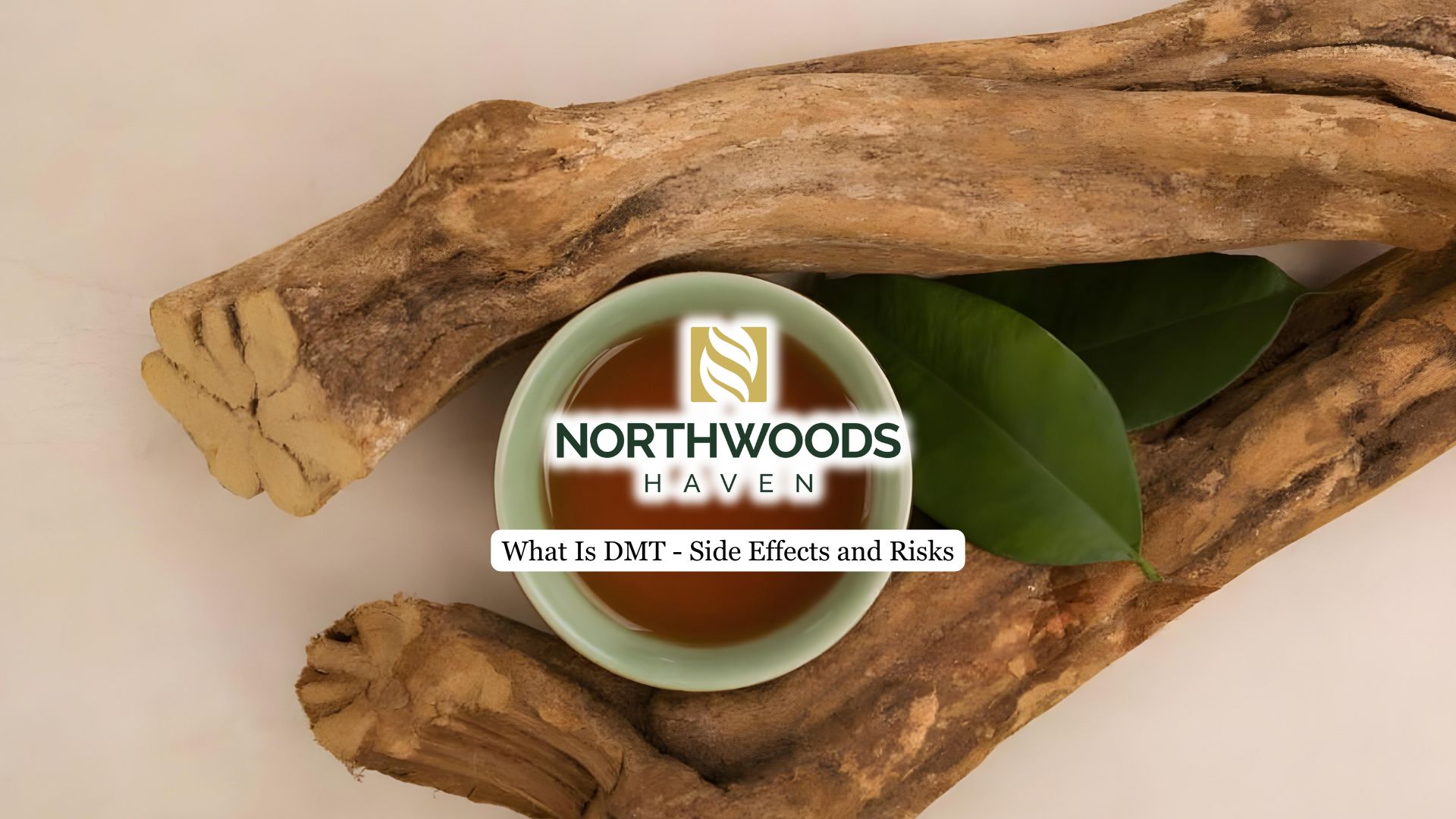Dimethyltryptamine (DMT) is a powerful hallucinogenic compound found naturally in certain plants and produced in small amounts in the human brain. Known for inducing intense, short-lived psychedelic experiences, DMT has gained attention for both its unique effects and its potential risks.
This article explores how DMT works, who uses it, its legal status, side effects, dangers, and what to do if use becomes problematic.
How DMT Works
When you use DMT, it rapidly targets serotonin receptors—especially the 5-HT2a subtype—responsible for influencing your mood, perception, and sense of reality. This interaction leads to profound changes in perception, mood, and cognition.
As DMT crosses the blood-brain barrier, it immediately stimulates these receptors, triggering a cascade of activity in the brain’s neural circuits. This action disrupts your standard sensory processing and emotional regulation, leading to the profoundly altered consciousness associated with a psychedelic trip.
The effects are rapid and intense, often described as transporting users to entirely different realms of consciousness, with vivid visual and auditory hallucinations, altered sense of time, and out-of-body experiences.
Also known as tryptamine, this substance is most commonly smoked, vaporized, or ingested as part of the traditional Amazonian brew ayahuasca. When smoked or vaporized, effects begin within seconds and last 30 to 45 minutes. In contrast, ayahuasca’s effects come on more slowly but can last several hours due to the presence of MAO inhibitors in the brew.
Prevalence and Patterns of Use
DMT use remains rare compared to other hallucinogens, but its popularity is increasing, especially among young adults in the United States. Most tryptamine users have prior experience with other psychedelics, such as LSD or psilocybin, and are more likely to be male, although use among females is also rising.
Patterns of use suggest that this psychedelic drug is often sought for its short, intense effects and is sometimes used in group settings or spiritual ceremonies. However, use is still uncommon in the general population, and most people who try DMT do so infrequently.
Like most hallucinogenic drugs, DMT misuse can lead to addiction because its psychedelic effects can compel you to repeatedly seek out the experiences brought by the drug to escape reality. Recognizing the signs that you need to seek help for addiction is crucial for timely intervention and recovery. One of these indicators is having the drive to continue using the substance despite adverse consequences.
If you’re looking for professional guidance, our outpatient treatment for hallucinogen addiction can help you safely recover from the psychological dependence and emotional instability often caused by hallucinogenic substances. The customized treatment plans we offer address the unique psychological effects of these drugs, including persistent perception disorders, mood instability, and recurring flashbacks.
Symptoms of Hallucinogen Use Disorder
Identifying addiction in yourself can be challenging, as the signs often develop gradually and can be hard to notice, especially when it comes to your behaviors. Signs and symptoms of hallucinogen use disorder may include:
- Taking more DMT than intended or for more extended periods
- Unsuccessful attempts to cut down or control use
- Spending excessive time obtaining, using, or recovering from DMT
- Cravings or intense urges to use DMT
- Failing to fulfill responsibilities at work, school, or home
- Continuing use despite social or interpersonal problems
- Abandoning essential activities in favor of DMT use
- Using DMT in physically hazardous situations
- Continued use despite awareness of physical or psychological harm
- Developing tolerance (needing more for the same effect)
If two or more of these symptoms persist for over a year, professional help may be warranted through a rehabilitation facility. Selecting the right rehab facility requires a careful evaluation of several critical factors to ensure the best chance of a successful recovery. The treatment approaches offered should include proven methods, such as evidence-based therapies.
Legal Status
Despite DMT’s rising popularity among diverse groups, its legal status remains strictly controlled in most places. In the United States, DMT is classified as a Schedule I controlled substance. This means it is illegal to possess, distribute, or manufacture DMT without special government permission.
The Schedule I status reflects the government’s view that DMT has high abuse potential and no accepted medical use despite ongoing research into its therapeutic potential.
Most countries share this strict stance, citing DMT’s powerful psychoactive effects and lack of approved medical uses as reasons for making it illegal or tightly regulated. While some nations make exceptions for research, which usually undergoes rigorous approval processes, or for certain religious and traditional practices (such as ceremonies using ayahuasca), unauthorized use or sale carries severe legal consequences.
Short-Term Effects
The hallmark of DMT is its rapid onset and profound, short-lived psychedelic effects. Common short-term effects include:
- Intense visual and auditory hallucinations
- Altered perception of time, space, and self
- Feelings of euphoria or joy
- Out-of-body experiences
- Perceived insights or mystical revelations
- Vivid colors and geometric patterns
Physical side effects can also occur, such as:
- Increased heart rate and blood pressure
- Dilated pupils
- Dizziness or lightheadedness
- Nausea (especially with ayahuasca)
- Agitation or anxiety

While many users report positive or transformative experiences, DMT can also cause frightening or disorienting trips, especially in high doses or unfamiliar settings.
Risks and Dangers
Although DMT is not considered physically addictive and does not produce classic withdrawal symptoms, it carries significant risks:
- Psychological distress: Bad trips can lead to intense fear, paranoia, or panic attacks.
- Accidents and injuries: Impaired perception and judgment can lead to hazardous behavior, particularly in unsafe environments.
- Medical complications: DMT can cause hypertension, seizures, or, rarely, loss of consciousness. Individuals with heart conditions or psychiatric disorders are at higher risk.
- Flashbacks: Some users experience hallucinogen persisting perception disorder (HPPD), where visual disturbances or flashbacks recur long after use.
- Interactions: Combining DMT with certain medications or other substances (especially MAO inhibitors) can be dangerous.
Long-Term Effects and Potential for Addiction
The long-term effects of DMT are not as well-studied as those of other drugs, but some potential issues include:
- Persistent psychosis: Ongoing mental health problems such as paranoia, mood swings, or visual disturbances.
- Flashbacks: Sudden, unexpected recurrences of hallucinations or altered perceptions, sometimes interfering with daily life.
- Psychological dependence: While DMT does not cause physical dependence, some users may develop a psychological reliance, seeking repeated experiences or using the drug to escape reality.
Compared to substances like alcohol or opioids, the risk of compulsive DMT use and physical addiction is considered low. However, repeated use can still lead to significant life disruptions and mental health issues.
Treatment and Recovery
Treatment for problematic DMT use or hallucinogen use disorder often involves a combination of approaches:
- Behavioral therapy: Cognitive-behavioral therapy (CBT) and addiction counseling techniques can help address underlying issues and develop healthier coping strategies.
- Support groups: Peer support, such as 12-step programs or group therapy, can offer encouragement and accountability.
- Medical supervision: In cases of severe psychological distress or co-occurring mental health issues, medical intervention may be necessary or dual diagnosis treatment.
- Education and harm reduction: Learning about the risks and safe practices can help prevent future problems.
Because DMT does not typically cause physical dependence, withdrawal management is usually not required, but psychological support is crucial for sustained recovery.
Final Thoughts from Northwoods Haven Recovery
While DMT is known for its powerful and sometimes transformative psychedelic experiences, it carries significant side effects and health risks that should not be overlooked.
At Northwoods Haven Recovery, we offer Outpatient Treatment Programs in Minneapolis, MN, which provide a compassionate and flexible path to recovery for individuals facing substance use disorders. Our programs are designed to accommodate your daily responsibilities, enabling you to balance work, school, and family commitments while receiving evidence-based therapies and holistic support tailored to your unique journey.



